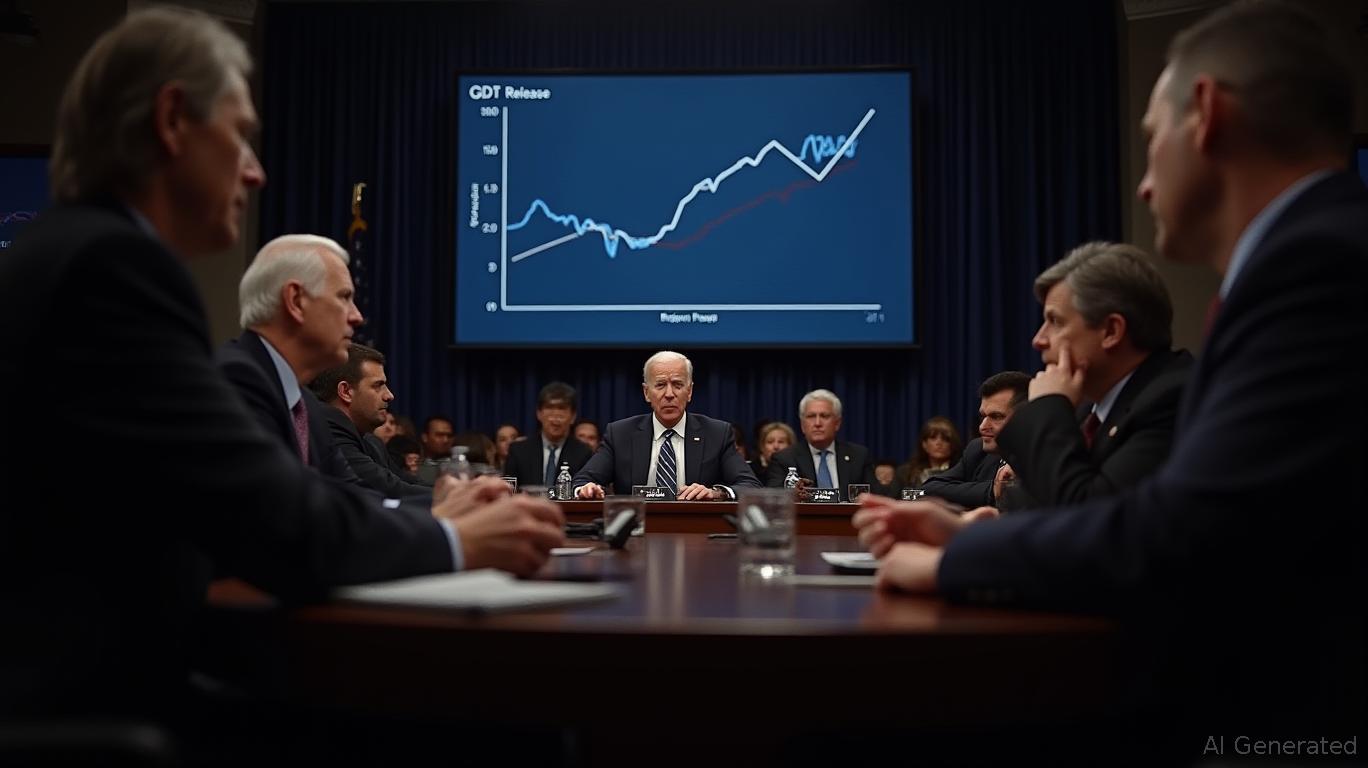U.S. Q1 GDP Contracts 0.2%, Reflecting Trade and Consumer Spending Challenges
Epic EventsFriday, May 30, 2025 4:03 am ET
The latest release of the U.S. Gross Domestic Product (GDP) data for the first quarter of 2025 highlights significant economic shifts amid ongoing trade tensions and consumer spending adjustments. This contraction, marking the first since 2022, is a crucial indicator for economists and investors as it reflects underlying economic vulnerabilities.
Introduction
The GDP data plays a pivotal role in shaping monetary policy and guiding economic outlooks. As a comprehensive measure of U.S. economic activity, GDP gauges the value of goods and services produced. The first quarter’s contraction by 0.2% underscores challenges posed by trade policies and shifts in consumer behavior. This decrease contrasts with the robust 2.4% growth seen in the previous quarter and highlights the impact of increased imports and reduced government spending.
Data Overview and Context
Gross Domestic Product (GDP) is a critical indicator of economic health, reflecting the inflation-adjusted value of all goods and services produced. The data, released by the Bureau of Economic Analysis (BEA), indicated a 0.2% annualized decline for Q1 2025, primarily driven by a surge in imports, which negatively impacts GDP calculations. The contraction deviates from historical averages and consensus expectations of a modest growth rate. The methodology accounts for changes in consumer spending, government expenditures, and investment levels.
Analysis of Underlying Drivers and Implications
Key factors driving the GDP contraction include a 42.6% increase in imports as businesses and consumers anticipated higher costs due to tariff announcements. Consumer spending growth slowed to its weakest pace since Q2 2023, while federal spending dropped significantly. These movements were partially offset by a notable rise in fixed investments and exports. The ongoing trade policy uncertainties contribute to a challenging economic environment, with potential long-term implications for market stability and policy adjustments.
Policy Implications for the Federal Reserve
The Federal Reserve closely monitors GDP as it influences monetary policy decisions. The contraction highlights economic vulnerabilities that may lead the Fed to adopt a cautious approach in adjusting interest rates. Although consumer spending and investment show resilience, the trade-induced slowdown presents challenges in achieving inflation targets and economic stability.
Market Reactions and Investment Implications
The GDP contraction has diverse impacts across markets. Treasury yields may fluctuate as investors reassess economic growth prospects, while equities might experience volatility due to uncertain consumer and business confidence. Currency markets could see shifts as trade tensions affect dollar strength. Investors might focus on sectors resilient to trade impacts, such as technology and domestic consumer goods, while considering the implications of government policy changes on investment strategies.
Conclusion & Final Thoughts
The first quarter GDP contraction underscores challenges posed by trade policies and consumer spending dynamics. While fixed investment and exports provide some offset, the broader economic implications necessitate careful policy consideration. Investors should remain attentive to upcoming data releases, including consumer spending and trade figures, which will offer further insights into economic trends and potential policy adjustments. As uncertainty persists, strategic investments in resilient sectors and careful monitoring of policy developments will be crucial.
Introduction
The GDP data plays a pivotal role in shaping monetary policy and guiding economic outlooks. As a comprehensive measure of U.S. economic activity, GDP gauges the value of goods and services produced. The first quarter’s contraction by 0.2% underscores challenges posed by trade policies and shifts in consumer behavior. This decrease contrasts with the robust 2.4% growth seen in the previous quarter and highlights the impact of increased imports and reduced government spending.
Data Overview and Context
Gross Domestic Product (GDP) is a critical indicator of economic health, reflecting the inflation-adjusted value of all goods and services produced. The data, released by the Bureau of Economic Analysis (BEA), indicated a 0.2% annualized decline for Q1 2025, primarily driven by a surge in imports, which negatively impacts GDP calculations. The contraction deviates from historical averages and consensus expectations of a modest growth rate. The methodology accounts for changes in consumer spending, government expenditures, and investment levels.
Analysis of Underlying Drivers and Implications
Key factors driving the GDP contraction include a 42.6% increase in imports as businesses and consumers anticipated higher costs due to tariff announcements. Consumer spending growth slowed to its weakest pace since Q2 2023, while federal spending dropped significantly. These movements were partially offset by a notable rise in fixed investments and exports. The ongoing trade policy uncertainties contribute to a challenging economic environment, with potential long-term implications for market stability and policy adjustments.
Policy Implications for the Federal Reserve
The Federal Reserve closely monitors GDP as it influences monetary policy decisions. The contraction highlights economic vulnerabilities that may lead the Fed to adopt a cautious approach in adjusting interest rates. Although consumer spending and investment show resilience, the trade-induced slowdown presents challenges in achieving inflation targets and economic stability.
Market Reactions and Investment Implications
The GDP contraction has diverse impacts across markets. Treasury yields may fluctuate as investors reassess economic growth prospects, while equities might experience volatility due to uncertain consumer and business confidence. Currency markets could see shifts as trade tensions affect dollar strength. Investors might focus on sectors resilient to trade impacts, such as technology and domestic consumer goods, while considering the implications of government policy changes on investment strategies.
Conclusion & Final Thoughts
The first quarter GDP contraction underscores challenges posed by trade policies and consumer spending dynamics. While fixed investment and exports provide some offset, the broader economic implications necessitate careful policy consideration. Investors should remain attentive to upcoming data releases, including consumer spending and trade figures, which will offer further insights into economic trends and potential policy adjustments. As uncertainty persists, strategic investments in resilient sectors and careful monitoring of policy developments will be crucial.

Disclaimer: The news articles available on this platform are generated in whole or in part by artificial intelligence and may not have been reviewed or fact checked by human editors. While we make reasonable efforts to ensure the quality and accuracy of the content, we make no representations or warranties, express or implied, as to the truthfulness, reliability, completeness, or timeliness of any information provided. It is your sole responsibility to independently verify any facts, statements, or claims prior to acting upon them. Ainvest Fintech Inc expressly disclaims all liability for any loss, damage, or harm arising from the use of or reliance on AI-generated content, including but not limited to direct, indirect, incidental, or consequential damages.

Comments
No comments yet